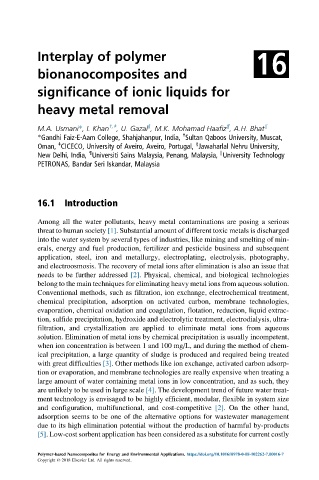Page 488 - Polymer-based Nanocomposites for Energy and Environmental Applications
P. 488
Interplay of polymer 16
bionanocomposites and
significance of ionic liquids for
heavy metal removal
§
¶
M.A. Usmani*, I. Khan †,‡ , U. Gazal , M.K. Mohamad Haafiz , A.H. Bhat k
†
*Gandhi Faiz-E-Aam College, Shahjahanpur, India, Sultan Qaboos University, Muscat,
§
‡
Oman, CICECO, University of Aveiro, Aveiro, Portugal, Jawaharlal Nehru University,
¶
New Delhi, India, Universiti Sains Malaysia, Penang, Malaysia, University Technology
k
PETRONAS, Bandar Seri Iskandar, Malaysia
16.1 Introduction
Among all the water pollutants, heavy metal contaminations are posing a serious
threat to human society [1]. Substantial amount of different toxic metals is discharged
into the water system by several types of industries, like mining and smelting of min-
erals, energy and fuel production, fertilizer and pesticide business and subsequent
application, steel, iron and metallurgy, electroplating, electrolysis, photography,
and electroosmosis. The recovery of metal ions after elimination is also an issue that
needs to be further addressed [2]. Physical, chemical, and biological technologies
belong to the main techniques for eliminating heavy metal ions from aqueous solution.
Conventional methods, such as filtration, ion exchange, electrochemical treatment,
chemical precipitation, adsorption on activated carbon, membrane technologies,
evaporation, chemical oxidation and coagulation, flotation, reduction, liquid extrac-
tion, sulfide precipitation, hydroxide and electrolytic treatment, electrodialysis, ultra-
filtration, and crystallization are applied to eliminate metal ions from aqueous
solution. Elimination of metal ions by chemical precipitation is usually incompetent,
when ion concentration is between 1 and 100 mg/L, and during the method of chem-
ical precipitation, a large quantity of sludge is produced and required being treated
with great difficulties [3]. Other methods like ion exchange, activated carbon adsorp-
tion or evaporation, and membrane technologies are really expensive when treating a
large amount of water containing metal ions in low concentration, and as such, they
are unlikely to be used in large scale [4]. The development trend of future water treat-
ment technology is envisaged to be highly efficient, modular, flexible in system size
and configuration, multifunctional, and cost-competitive [2]. On the other hand,
adsorption seems to be one of the alternative options for wastewater management
due to its high elimination potential without the production of harmful by-products
[5]. Low-cost sorbent application has been considered as a substitute for current costly
Polymer-based Nanocomposites for Energy and Environmental Applications. https://doi.org/10.1016/B978-0-08-102262-7.00016-7
Copyright © 2018 Elsevier Ltd. All rights reserved.

